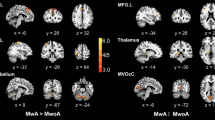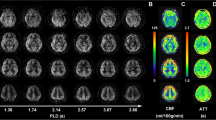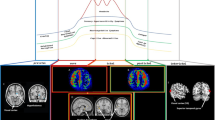Summary
High-resolution, color-coded images of local cerebral blood flow (LCBF) were made utilizing stable xenon-enhanced computed tomography among patients with common migraine (n=18), classic migraine (n=12) and cluster headache (n=5). During spontaneously occurring headache in common and classic migraine patients, LCBF values for cerebral cortex and subcortical gray and white matter were diffusely increased by 20–40% with the exception of the occipital lobes. LCBF increases involved both hemispheres whether the head pain was unilateral or bilateral. No significant differences were noted in the degree or pattern of LCBF increases during headaches of common and classic migraineurs. Similar cerebral hyperperfusion of greater magnitude was observed during cluster headaches but was more prominent on the side of the head pain. Present observations do not support the hypothesis of spreading cortical depression as a cause of classic migraine. From a hemodynamic viewpoint, LCBF increases during headaches of common or classic migraine or cluster appear similar. Evidence is adduced that sympathetic hypofunction with denervation hypersensitivity of cerebral vessels plays a role in the cerebral hyperperfusion of migraine headaches. More pronounced unilateral autonomic derangements appear to account for the symptoms and cerebral hyperperfusion associated with cluster headaches.
Similar content being viewed by others
References
Lance JW (1987) The pathophysiology of migraine. In: Dalessio DJ (ed) Wolff's headache and other head pain, 5th edn. Oxford University Press, New York, pp 58–86
Meyer JS, Hata T, Imai A (1987) Evidence supporting a vascular pathogenesis of migraine and cluster headache. In: Blau JN (ed) Migraine: clinical, therapeutic, conceptual and research aspects. Chapman and Hall, London, pp 265–302
Schumacher GA, Wolff HG (1941) Experimental studies on headache. A. Contrast of histamine headache with the headache of migraine and that associated with hypertension. B. Contrast of vascular mechanisms in preheadache and in headache phenomena of migraine. Arch Neurol Psychiatry 45: 199–214
Skinhoj E (1973) Hemodynamic studies within the brain during migraine. Arch Neurol 29: 95–98
Norris JW, Hachinski VC, Cooper PW (1975) Changes in cerebral blood flow during a migraine attack. Br Med J 3: 676–677
Mathew NT, Hrastnik F, Meyer JS (1986) Regional cerebral blood flow in the diagnosis of vascular headache. Headache 15: 252–260
Edmeads J (1977) Cerebral blood flow in migraine. Headache 17: 148–152
Sakai F, Meyer JS (1978) Regional cerebral hemodynamics during migraine and cluster headaches measured by the133Xe inhalation method. Headache 18: 122–132
Meyer JS, Zetusky W, Jonsdottir M, Mortel K (1986) Cephalic hyperemia during migraine headaches: a prospective study. Headache 26: 388–397
Juge O (1988) Regional cerebral blood flow in the different clinical types of migraine. Headache 28: 537–549
Moskowitz MA (1984) The neurobiology of vascular head pain. Ann Neurol 16: 157–168
Gotoh F, Komatsumoto S, Araki N, Gomi S (1984) Noradrenergic nervous activity in migraine. Arch Neurol 41: 951–955
Olesen J, Larsen B, Lauritzen M (1981) Focal hyperemia followed by spreading oligemia and impaired activation of rCBF in classic migraine. Ann Neurol 9: 344–352
Lauritzen M, Skyhoj Olsen T, Lassen NA, Paulson OB (1983) Changes in regional cerebral blood flow during the course of classic migraine attacks. Ann Neurol 13: 633–641
Leao AAP (1944) Spreading depression of activity in the cerebral cortex. J Neurophysiol 7: 359–390
Welch KMA (1987) Migraine: A biobehavioral disorder. Arch Neurol 44: 323–327
Kudrow L (1980) Cluster headache. Mechanisms and management. Oxford University Press, Oxford, pp 10–38
Kobari M, Meyer JS, Lotfi J, Ichijo M (1990) Calcium antagonists and the treatment of cluster headache. In: Gallagher M (ed) Drug therapy for headache. Dekker, New York (in press)
Meyer JS, Shinohara T, Imai A, Kobari M, Sakai F, Hata T, Oravez WT, Timpe GM, Deville T, Solomon E (1988) Imaging local cerebral blood flow by Xenon-enhanced computed tomography-Technical optimization procedures. Neuroradiology 30: 283–292
Imai A, Meyer JS, Kobari M, Ichijo M, Shinohara T, Oravez WT (1988) LCBF values decline while Lλ values increase during normal human aging measured by stable xenon-enhanced computed tomography. Neuroradiology 30: 463–472
Ad Hoc Committee on Classification of Headache (1962) Classification of headache. JAMA 179: 127–128
Headache Classification Committee of the International Headache Society (1988) Classification and diagnostic criteria for headache disorders, cranial neuralgias and facial pain. Cephalalgia 8 [Suppl 7]: 1–96
Kobari M, Meyer JS, Ichijo M, Imai A, Oravez WT (1989) Hyperperfusion of cerebral cortex, thalamus and basal ganglia during spontaneously occurring migraine headaches. Headache 29: 282–289
Robertson WM, Welch KMA, Levine SR, Schultz LR (1989) The effects of aging on cerebral blood flow in migraine. Neurology 39: 947–951
O'Leary JL, Goldring S (1959) Changes associated with forebrain excitation processes: d. c. potentials of the cerebral cortex. In: Magoun HW (ed) Handbook of Physiology, section 1: Neurophysiology, vol 1. American Physiological Society, Washington, pp 315–328
Gloor P (1986) Migraine and regional cerebral blood flow. Trends Neurosci 9: 21
Leao AAP (1944) Pial circulation and spreading depression of activity in the cerebral cortex. J Neurophysiol 7: 391–396
Hansen AJ, Quistorff B, Gjedde A (1980) Relationship between local changes in cortical blood flow and extracellular K+ during spreading depression. Acta Physiol Scand 109: 1–6
Shinohara M, Dollinger B, Brown G, Rapoport S, Sokoloff L (1979) Cerebral glucose utilization: local changes during and after recovery from spreading cortical depression. Science 203: 188–190
Laurizen M, Jorgensen MB, Diemer NH, Gjedde A, Hansen AJ (1982) Persistent oligemia of rat cerebral cortex in the wake of spreading depression. Ann Neurol 12: 469–474
Andersen AR, Friberg L, Skyhoj Olsen T, Olesen J (1988) Delayed hyperemia following hypoperfusion in classic migraine: single photon emission computed tomographic demonstration. Arch Neurol 45: 154–159
Skinhoj E, Olsen T, Lassen NA (1989) Blood flow and vascular reactivity during attacks of classic migraine-Limitations of the Xe-133 intraarterial technique. Headache 29: 15–20
Dalessio DJ (1987) A classification of headache. In: Dalessio DJ (ed) Wolff's headache and other head pain, 5th edn. Oxford University Press, New York, pp 3–13
Anthony M (1981) Biochemical indices of sympathetic activity in migraine. Cephalalgia 1: 83–89
Edvinsson L, MacKenzie ET (1976) Amine mechanisms in the cerebral circulation. Pharmacol Rev 28: 275–348
Yamamoto M, Meyer JS (1980) Hemicranial disorder of vasomotor adrenoceptors in migraine and cluster headache. Headache 20: 321–335
Levine SR, Welch KMA, Ewing JR, Joseph R, D'Andrea G (1987) Cerebral blood flow asymmetries in headache-free migraineurs. Stroke 18: 1164–1165
Sakai F, Meyer JS (1979) Abnormal cerebrovascular reactivity in patients with migraine and cluster headache. Headache 19: 257–266
Broch A, Horven I, Nornes H, Sjaastad O, Tonjum A (1970) Studies on cerebral and ocular circulation in a patient with cluster headache. Headache 10: 1–8
Nelson RF, du Boulay GH, Marshall J, Russell RWR, Symon L, Zilkha E (1980) Cerebral blood flow studies in patients with cluster headache. Headache 20: 184–189
Krabbe AAE, Henriksen L, Olesen J (1984) Tomographic determination of cerebral blood flow during attacks of cluster headache. Cephalalgia 4: 17–23
Hardebo JE (1984) The involvement of trigeminal substance P neurons in cluster headache. An hypothesis. Headache 24: 294–304
Author information
Authors and Affiliations
Rights and permissions
About this article
Cite this article
Kobari, M., Meyer, J.S., Ichijo, M. et al. Cortical and subcortical hyperperfusion during migraine and cluster headache measured by Xe CT-CBF. Neuroradiology 32, 4–11 (1990). https://doi.org/10.1007/BF00593934
Received:
Issue Date:
DOI: https://doi.org/10.1007/BF00593934




